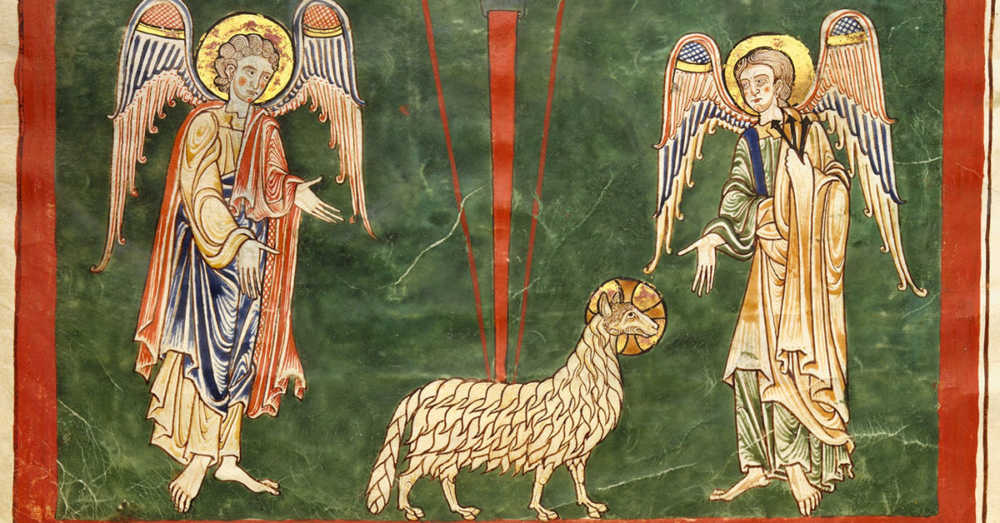We run our website the way we wished the whole internet worked: we provide high quality original content with no ads. We are funded solely by your direct support. Please consider supporting this project.

What Is God’s Glory?
In John 12 we find a view of God’s glory that challenges many modern notions of what the glory of God means. In this passage, we find that Jesus was “troubled” by the cross that lay ahead to such an extent that he wanted to cry out, “Father, save me.” But Jesus quickly expresses his resolve to go forward by saying, “No, it was for this very reason that I have come to this hour.” Then, with a view towards his crucifixion, Jesus exclaims: “Father, glorify your name,” at which point the voice of the Father thunders from the sky: “I have gloried it, and will glorify it again.” Jesus then goes on to declare: “when I am lifted up from the earth, I will draw all people to myself.” And just to make sure readers did not miss the point, John adds: “He said this to show the kind of death he was going to die” (12:27-8, 31-3).
This passage unambiguously identifies Jesus’ crucifixion as the “hour” when he will “glorify” the Father’s “name.” In ancient Jewish culture, to speak of a person’s “name” was to speak about their character and reputation. So, Jesus and the Father are both indicating that the Father’s character would most clearly shine forth—be “glorified”—when Jesus was crucified. While Jesus reflects the Father’s cruciform character throughout his ministry, the Father is “most glorified through the…‘lifting-up’… of the Son,” as Andrew Moody notes. Similarly, Gary Burge observes that, while God was of course glorified in Jesus’ miracles, it is only “on the cross that the mysterious, unfathomable glory of God is to be found.”
Colin Gunton argued that “[The glory of Christ is] lived up on the cross, and only through the trial of death is elevated to the glory that is reigning with the Father… if it is true that those who have seen him have seen the Father, then it is the Father who is revealed in the incarnate humanity of this man glorified through humbling.”
On top of this, Jesus tells us that it was “for this very reason” that he came into the world. As N.T. Wright puts it, the supreme glorification of the Father on the cross was “the climax and purpose of his whole work.” For, as Wright goes on to note, “in being thus ‘lifted up’…Jesus will draw all people to himself. How could it not be so, if indeed his cross is the true revelation of the true God, and if what we see in that revelation is the face of love?”
Now, if the crucifixion is the “climax and purpose of Jesus’ work,” we should understand everything else Jesus taught and did from this vantage point. To put it differently, since the cross was the supreme glorification of the Father, then the many other lesser ways Jesus glorified the Father should be understood as anticipating, and pointing toward, this event.
Let’s think about this another way. If Jesus is the center to which all Scripture points, then the cruciform glory of God that was supremely revealed on the cross must be regarded as the epicenter of this center. On this note, it’s significant that, when the resurrected Jesus “explained… all Scriptures concerning himself” to the disciples on the road to Emmaus, it was primarily to demonstrate that “the Messiah [had] to suffer these things,” which the disciples themselves had witnessed (Lk 24:26-7). And later, when Jesus “opened” the “minds” of the apostles “so they could understand the Scriptures,” it was primarily so they could see that it declared that “[t]he Messiah will suffer and rise from the dead on the third day” (vv.45-6).
What a strange glory!
—Adapted from Cross Vision, pages 37-38
Category: General
Tags: Character of God, Cross Vision, Crucifixion, Crucifixion of the Warrior God, Cruciform Theology, Glory
Related Reading

How To Talk about Theology
Social media is full of theological debate. Theological arguments that formerly took months or even years to get in print, now only takes the time to write a post or 140 characters and click “publish.” Social media is great in that it makes space for all of our voices. However, it also seems to elevate…

Podcast: How Do You Teach a Cruciform Hermeneutic from the Pulpit?
Greg talks about infallibility and inerrancy. http://traffic.libsyn.com/askgregboyd/Episode_0281.mp3

Cruciform Aikido Pt 2: God-Forsaken Judgment
So if Jesus is the supreme revelation of what God is like, as we explained in our last post, what does that tell us about the nature of God’s judgment?
As Jesus was dying on the cross he cried out, “Eli, Eli, lema sabachthani?,” which means, “My God, my God, why have you forsaken me?” (Mt. 27:46). This shocking cry reveals…

Podcast: Is Cruciform Hermeneutics Simply Midrash?
Greg considers whether Cruciform Hermeneutics is just a complicated way of seeing what I want to see in the text, and offers nuanced thought for our more complicated hermeneutical challenges. http://traffic.libsyn.com/askgregboyd/Episode_0307.mp3

Sermons: The Church – Week Five
In week five of this sermon series, Greg Boyd discusses what the church should look like in the lens of the cross. A universal Church was born out of the ministry of Jesus, and this Church is empowered to look like the Cross. In this sermon, Greg shows us why it’s so important, as the…

Podcast: Would a Loving Messiah Call a Woman a DOG?!?
Greg talks about why Jesus would say such apparently cruel things to some poor Canaanite woman. Oh, he also tells a joke about hamsters. http://traffic.libsyn.com/askgregboyd/Episode_0202.mp3
